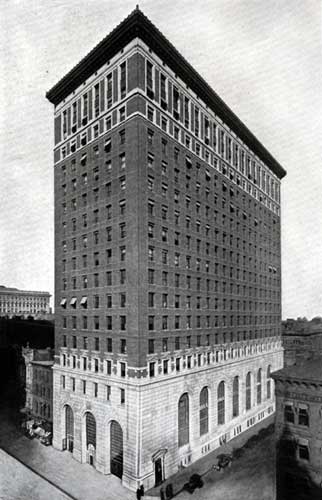The Marine by Any Other Name & Address: Part 1
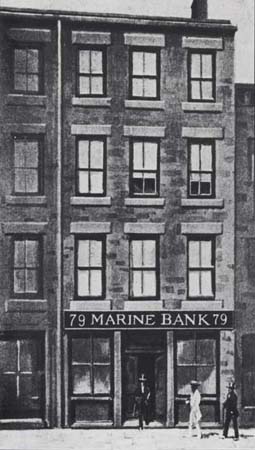 In mid-August, 1850, Buffalo was "hot" in more ways than one. Buffalo already had ten commerical banks operating, but eight investors thought there was room for one more.
In mid-August, 1850, Buffalo was "hot" in more ways than one. Buffalo already had ten commerical banks operating, but eight investors thought there was room for one more.
They opened a state bank at 79 Main Street in Buffalo, calling it the Marine Bank. The largest stockholder, General James S. Wadsworth, was from Geneso; others were from Bath, Kinderhook, Medina. Only two, George Palmer and James M. Ganson, were from Buffalo. But their capital investment in the new bank, $170,000, was more than sufficient to ensure the bank's early success. It occupied first the east side of Main Street, and then the west side of Main adjoining the Erie Canal, source of Buffalo's wealth.

Image source: 1872 Hopkins Atlas, NYPL
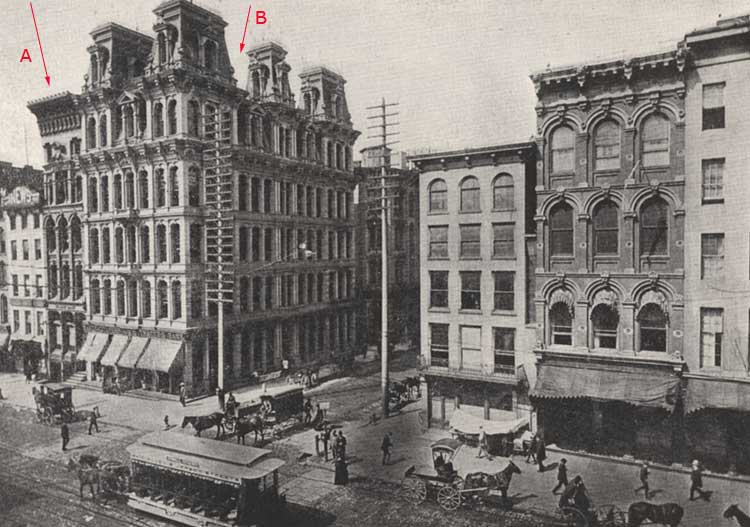
The east side of Main Street, showing Main and Seneca Streets, c. 1880 Image source: Picture Book of Earlier Buffalo
By 1880, the bank moved away from the waterfront to a tall, slender building at 220 Main Street ("A" above).
The Marine Bank continued to grow and in 1896 it acquired the much larger building next door at the northeastern corner of Main and Seneca Street ("B" above). Known as the J.F. Haven building, it was a pre-1875 cast iron building six stories tall. It had been designed by M.E. Beebe & Son in the second empire style.

Image source: The History of of Buffalo, 1908, BEN
In 1901, the buildings were "modernized" at right. (Note that the telephone pole seen in the earlier image above has been removed by 1901.)
After being a state bank for 52 years, Marine applied to become a national bank and became the Marine National Bank of Buffalo. Along the way, it had acquired the American Exchange Bank and the Buffalo Commerical Bank.
The bank's assets were $20 million dollars in 1907, and the bank was forced to enlarge the lobby to add more tellers. The company was already looking ahead for property on which to construct its own building.
The Marine's board of directors in 1908 was a roster of Buffalo's prominent citizens: Stephen M. Clement (president), John J. Albright (vice-president), Charles Goodyear, William Gratwick Jr., Edmund Hayes, George B. Mathews, Moses Taylor, etc.

Interior of the bank in 1901. Image source: Pan-American Souvenir booklet
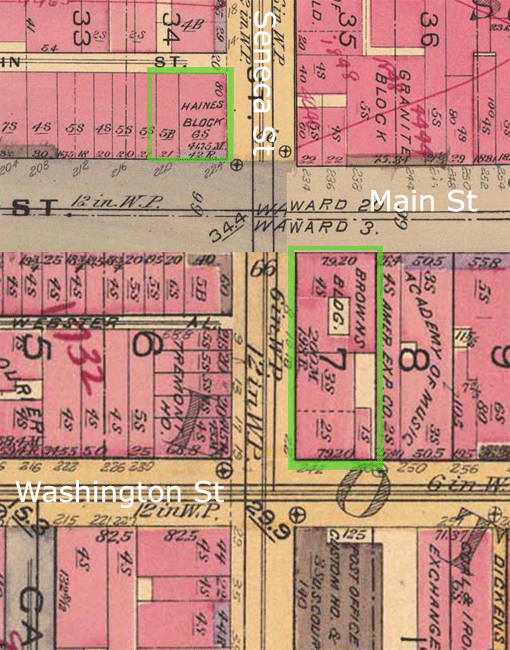
1895 city atlas. The upper green box shows the bank's location at the northwest corner of Main & Seneca.
The lower green box shows the block on which the Marine Bank would build.

The Brown building, northeast corner Main and Seneca, c. 1900, occupied the location of the new bank. At left is the Bank of Buffalo building, Buffalo's other domed bank. Image source: Picture Book of Earlier Buffalo

Seneca and Washington (Brown Building at left). Image source: Picture Book of Earlier Buffalo
The corner building had been Buffalo's post office from 1842 - 1858. In 1842, 2, 210,230 letters passed through the building.
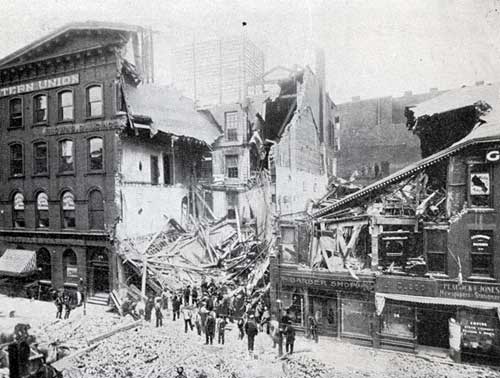
The site along Seneca Street from Main Street to Washington Street which the Marine Bank selected for construction of its building had a sketchy past. The Brown building, rumored falsely to be owned by Queen Victoria, was built in 1858. It had a fire and was reconstructed. Then, in May 1896, a portion of it collapsed, seen at left.
Marine Bank demolished some of the city's oldest structures for its new building.
Image source: Express Yearbook, 1897
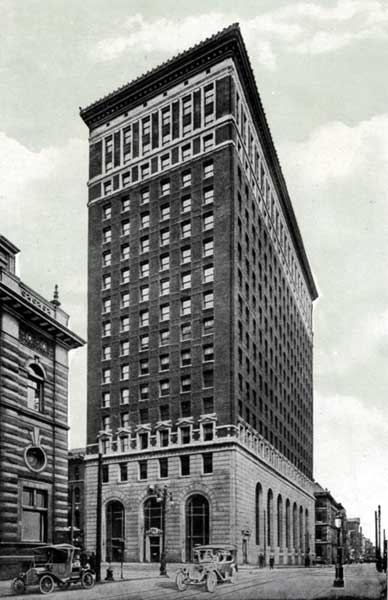 |
The Buffalo firm of E.B. Green and Associates was selected to design the 1915 Marine National Bank building, 17 stories tall. The base was of white sandstone; its basement vault doors were 34 tons each. Images source: private collection |

237 Main Seneca Building today
1918 found the company boasting that it had over $80 million dollars in resources. Its chairman of the board was George F. Rand, who had begun as a bank messenger in a North Tonawanda bank, and opened his own private bank at 21. Rand became chairman of Marine at age 36 and initiated branch banks in Buffalo. The board of directors in 1918 included A. Conger Goodyear, Walter P. Cooke, John D. Larkin, Orin Foster, Howard Forman, Richard Wilhelm, Jacob Schoellkopf, etc. The bank had resumed its status as a state bank and in 1919 changed its name to the Marine Trust Company of Buffalo. Tragedy would strike the Rand family in 1919 when George F. Rand was killed in a plane crash in England while on a postwar philanthropic mission. His son, George F. Rand, Jr. would take his place and move Marine forward dramatically in the Roaring Twenties. In 1929, days before the stock market crash in October, the company sold one million shares of its offering at $60 per share; it had formed a holding company called Marine Midland Corporation and, by the end of 1929, owned 97.2% capital stock in 17 state banks from Albion to Niagara Falls to Troy. Its deposits were $216 million, it had 33 branches, and it successfully weathered the Depression.
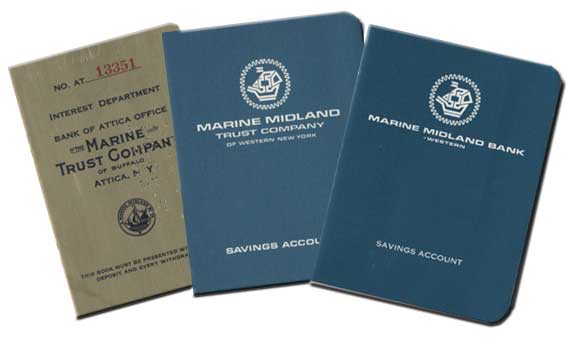
Marine continued to acquire banks in the postwar era, and in the 1950s renamed itself Marine Midland Trust Company of Western New York. In 1964 the bank logo of the sailing ship was replaced by a new ship symbol. But the 1960s were to hold much bigger changes to the Marine than this because the company needed much more room.
